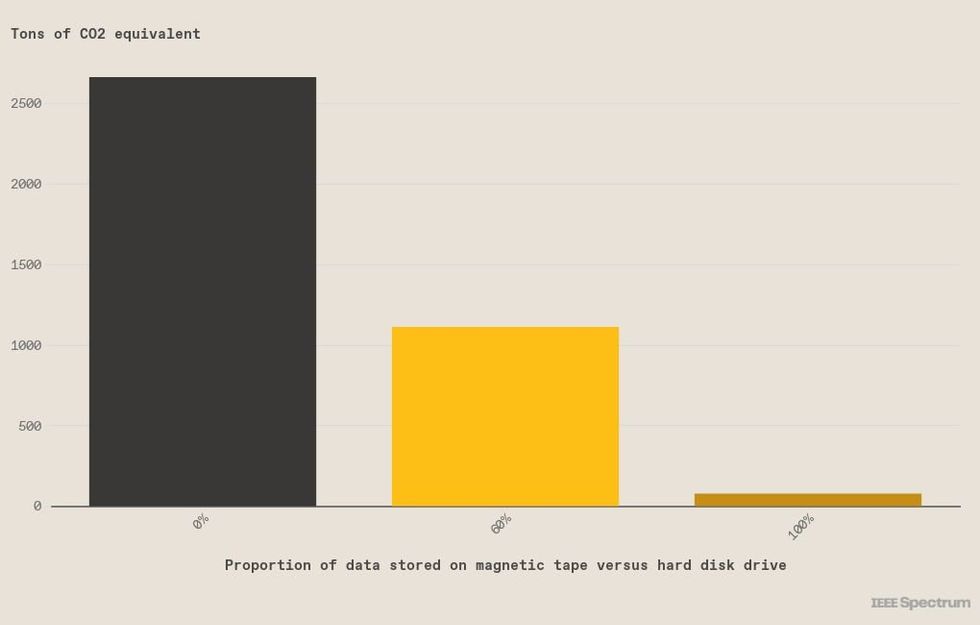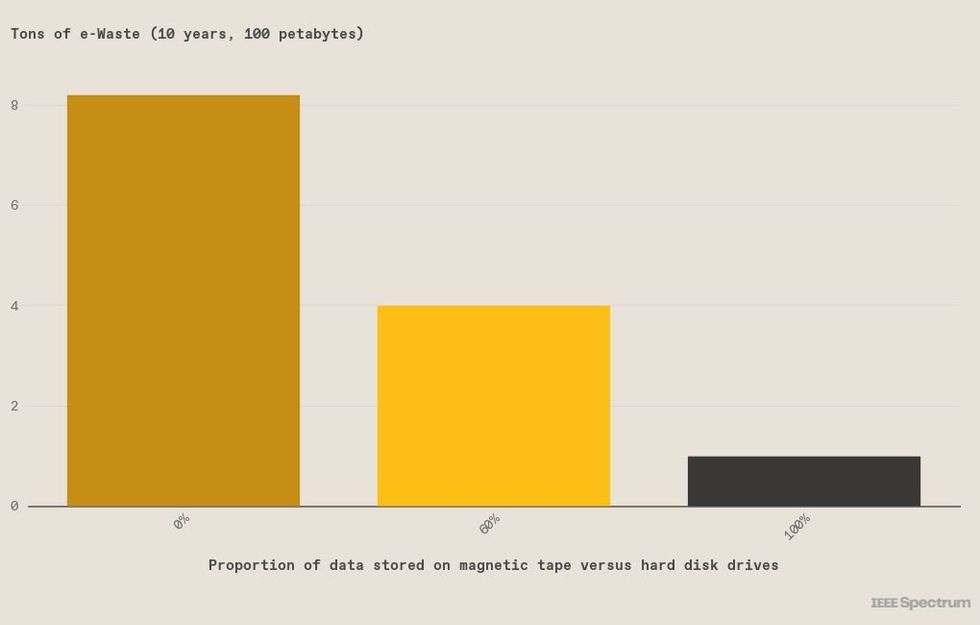This text is a part of our unique IEEE Journal Watch collection in partnership with IEEE Xplore.
Information storage has lengthy contributed a good portion of the computing business’s carbon footprint, even representing as a lot as 1.8 % of america’ whole electrical energy consumption in 2014, in line with a report by the
Berkeley Nationwide Laboratory [pdf]. Brad Johns, a veteran of IBM’s information storage enterprise and an information storage marketing consultant in Arizona, believes that the answer to information storage sustainability, for the foreseeable future at the least, lies in a chunk of know-how many would possibly contemplate already outdated: the magnetic information tape.
“There’s a chance that many organizations have to cut back their carbon footprint and do it in a approach that might scale back their prices… that’s type of a win-win,” says Johns.
No less than 60 % of all information is “chilly,” but stays on HDDs. Which presents a chance to transition to a greener—and cheaper—different.
The necessity for information storage is just rising, too. Worldwide Information Company (IDC) estimated that the whole quantity of knowledge created would enhance from 33 zettabytes in 2018 to 175 ZB in 2025, and that round 10 %, or 17 ZB, of that information can be saved in 2025. In keeping with estimates by IDC and Seagate cited in 2021, 62 % of knowledge is saved on HDDs, 9 % on stable state drives (SSDs), and 15 % on tape in 2021.
HDDs are extra handy for storage as a result of info will be retrieved from them a lot sooner than it may be retrieved from tape storage. The tradeoff is increased carbon emissions,
Johns explains in an article for Movement Picture Journal—HDDs have a lifespan of roughly 5 years, throughout which era they produce round 2.55 equal kilograms of carbon dioxide per terabyte per yr (based mostly on an estimate from Seagate for the Exos X18 HDD). In distinction, tape media has a lifespan of greater than 30 years, throughout which era they produce simply 0.07 kg CO2e/TB/yr (based mostly on an estimate from Fujifilm for the LTO 9 [pdf]), or 3 % that of HDDs.
Tape Storage Saves Carbon
 The bars on this graph point out the local weather financial savings accrued in switching out “chilly” information (i.e. information not often accessed however nonetheless indisposable) from laborious drives to magnetic tape. Supply: Brad Johns Consulting
The bars on this graph point out the local weather financial savings accrued in switching out “chilly” information (i.e. information not often accessed however nonetheless indisposable) from laborious drives to magnetic tape. Supply: Brad Johns Consulting
Johns factors out that many of the huge inflow of knowledge being created and saved at the moment is “chilly information,” information that’s not often accessed however nonetheless has worth and can’t be discarded. In keeping with a
2019 whitepaper by IDC [pdf], 60 % of all information is chilly, but stays on HDDs. Johns argues that this presents an necessary alternative for large information companies to transition to an alternate, tape storage, a extra sustainable type of information storage which would scale back their carbon footprint.
If organizations worldwide collectively transitioned all their chilly information, a collective 60 % of all information, to tape, the quantity of carbon dioxide emitted by information storage throughout the globe would fall by 58 %, a 79 million ton discount in CO2 emissions, Johns calculates.
Lowering e-Waste
Tape Storage Saves e-Waste
 In the meantime, this graph signifies how a lot e-waste can also be saved by switching a portion of the world’s “chilly” saved information from laborious drives to magnetic tape. Supply: Brad Johns Consulting
In the meantime, this graph signifies how a lot e-waste can also be saved by switching a portion of the world’s “chilly” saved information from laborious drives to magnetic tape. Supply: Brad Johns Consulting
Transitioning chilly information to be saved on fashionable tape media additionally reduces
digital waste (e-Waste). Since HDDs solely have a 5 yr lifespan, the outdated HDDs will have to be discarded for brand spanking new ones to retain the identical information. Tape storage is usually changed each ten years, leading to much less discarded storage. For example, if an information middle must retailer 100 Petabytes of knowledge for 10 years, storing all information on HDDs leads to 7.4 metric tons of e-Waste. If 60 % of the info is moved to tape, solely 3.6 metric tons of e-Waste are generated, leading to a 51 % discount.
“Tape at the moment clearly has a compelling benefit over laborious disk drives. And for those who take a look at the roadmaps, it’s going to remain that approach most likely for the subsequent decade.”
—Brad Johns, Brad Johns Consulting
Additional incentive for this answer is the monetary profit, argues Johns. Utilizing Fujifilm’s whole value of possession (TCO) device, he calculated that storing all 100 PB of knowledge on HDD prices US $17,707,468, whereas a combination that features 60 % tape cuts the fee practically in half to $9,476,339.
Many huge companies have already began shifting towards tape storage. For smaller corporations, nevertheless, the method of shifting to tape has been slower. The definition of chilly information is variable, and depends upon particular person organizations’ wants and person necessities. Thus, categorizing information as “chilly” in order that it may be moved to tape is tricky–and prices time, cash, and energy. Whereas massive companies might have these assets, smaller corporations don’t. This is without doubt one of the obstacles stopping tape storage from being broadly applied in smaller scale information facilities.
The opposite impediment Johns describes is the administration problem. “The know-how is fairly confirmed. It’s simply attempting to get the momentum amongst all the opposite issues that IT organizations should do,” he says.
No matter whether or not companies implement the answer, the query stays whether or not tape storage is the answer that’s right here to remain. “Tape at the moment clearly has a compelling benefit over laborious disk drives, and for those who take a look at the roadmaps, it’s going to remain that approach most likely for the subsequent decade,” says Johns. However there’s lively analysis into options.
Microsoft, for instance, has invested in analysis for DNA-based storage choices, he factors out. However, “there’s nonetheless quite a lot of analysis to be completed and engineering to really flip it into one thing,” he says.
From Your Website Articles
Associated Articles Across the Net

